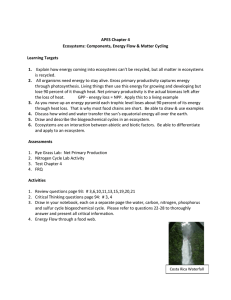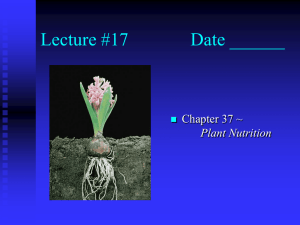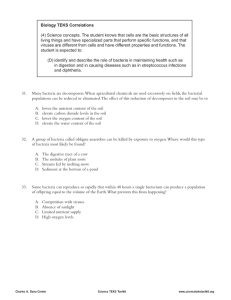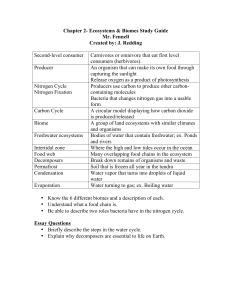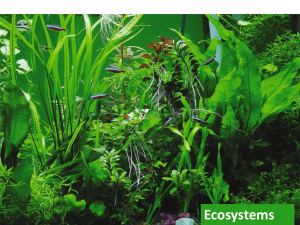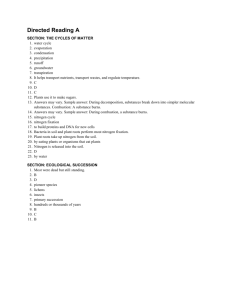Biogeochemical Cycles Lecture 11 Chapter 23
advertisement
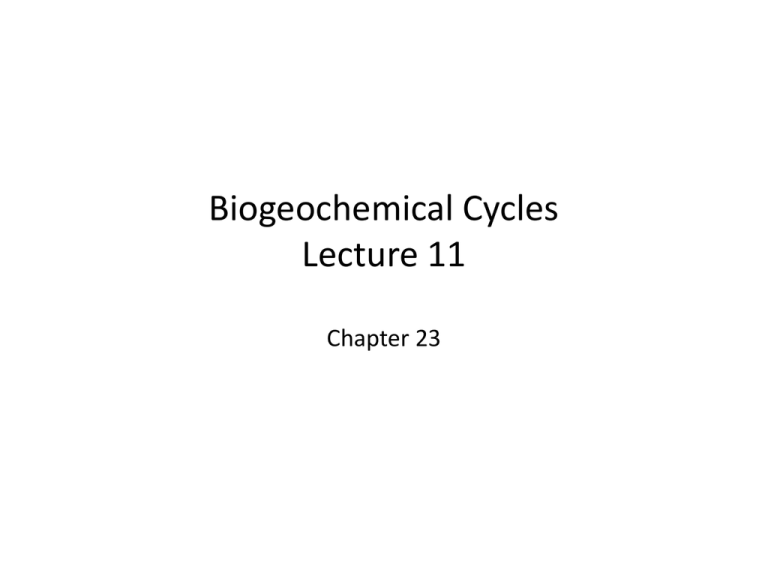
Biogeochemical Cycles Lecture 11 Chapter 23 Nutrients – Macronutrients: Organism would fail completely C, H, O, N, P, K, Ca, Mg, S Micronutrients: required as cofactors, components of certain molecules Cl, Fe, Mn, B, Cu,. Mo, Zn, Ni Availability is influenced by pH … (See 6.12) • Life depends on recycling chemical elements • Nutrient circuits in ecosystems involve biotic and abiotic components and are often called biogeochemical cycles • Focus on: – Each chemical’s biological importance – Forms in which each chemical is available or used by organisms – Major reservoirs for each chemical – Key processes driving movement of each chemical through its cycle Fixation Mineralization Fixation Mineralization Exchange Pool Two food chains: • Grazing food chain – Herbivore carnivore • Detritus food chain – Dead matter and waste from grazing food chain and primary production – Provides input to grazing food chain Detrivore food chain heterotrophs: feed on dead material Provide prey in herbivore foodchain Fragmentation: 1. Microfauna and flora <100um Protozoans and nematodes 2. Mesofauna 100um 2mm Mites, potworms, springtails 3. Macrofauna Millipedes, earthworms, snails, amphipods & isoods Decomposition: Bacteria and fungi – produce extracellular enzymes Fungi belong to a separate kingdom several groups produce long, threadlike strands (hyphae) reproductive structures may be large and visible Bacteria: two distinct kingdoms Single celled Microscopic Various shapes Many may not be easily cultured May develop populations quickly Study of Decomposition – Litterbag Studies • Weighed sample in mesh bag placed in soil • Withdrawn after time to determine remaining dry-weight – Dry weight estimate distorted by biomass of decomposer • Gives estimate of decomposition impacted by – Species – conditions Other factors which may impact rate of decomposition? Decomposition of red maple leaves more rapid in warmer, more humid climatesdde Two types of biogeochemical cycles based input source to ecosystems • Sedimentary – Rock and salt solution phases • Gaseous – Global • Many cycles hybrid – Exchange pool – Reservoir Carbon cycle: • Closely tied to energy flux • Major exchange pool: atm CO2 (at ~0.03% ) • Uptake via photosynthesis • Immobilized in carbonates of shells, fossil fuels • Subject to daily + seasonal flux The Phosphorus Cycle • Phosphorus is a major constituent of nucleic acids, phospholipids, and ATP • Phosphate (PO43–) is the most important inorganic form of phosphorus • The largest reservoirs are sedimentary rocks of marine origin, the oceans, and organisms • Phosphate binds with soil particles, and movement is often localized Fig. 55-14d Precipitation Geologic uplift Weathering of rocks Runoff Consumption Decomposition Plant uptake of PO43– Plankton Dissolved PO43– Uptake Sedimentation Soil Leaching Nitrogen cycle: • N essential to life – amino acids, nucleic acids • Atm. N2 stable, difficult bond to break • Fixation largely biological (ca 90%); agricultural use requires fossil fuel input • Fixation of N N – Free living aerobics as Azotobacter, & certain cyanobacter – Lichen symbionants – Mutualists associated with certain plant groups (Rhizobium spp. on leguminous plants) Ammonium form available to plants Ammonia (gas) N2 N+N (NH3)2 NH4 H + energy Under acidic conditions converts to ammonium but may be lost to atmosphere Nitrate produced by soil bacteria from ammonium may also be taken up by plants or mineralized to N2 NO3 • Organic nitrogen is decomposed to NH4+ by ammonification, and NH4+ is decomposed to NO3– by nitrification (2 step processes, involving 2 different soil bacteria: Nitrosomonas and Nitrobacter) • Denitrification converts NO3– back to N2 – Anaerobic, involves Pseudomonas spp • Soil pH impacts both processes (low pH inhibits) Fig. 55-14c N2 in atmosphere Assimilation NO3– Nitrogen-fixing bacteria Decomposers Ammonification NH3 Nitrogen-fixing soil bacteria Nitrification NH4+ NO2– Nitrifying bacteria Denitrifying bacteria Nitrifying bacteria Human activities now dominate most chemical cycles on Earth • As the human population has grown, our activities have disrupted the trophic structure, energy flow, and chemical cycling of many ecosystems Nutrient Enrichment • In addition to transporting nutrients from one location to another, humans have added new materials, some of them toxins, to ecosystems Agriculture and Nitrogen Cycling • The quality of soil varies with the amount of organic material it contains • Agriculture removes from ecosystems nutrients that would ordinarily be cycled back into the soil • Nitrogen is the main nutrient lost through agriculture; thus, agriculture greatly affects the nitrogen cycle • Industrially produced fertilizer is typically used to replace lost nitrogen, but effects on an ecosystem can be harmful Fig. 55-17 Contamination of Aquatic Ecosystems • Critical load for a nutrient is the amount that plants can absorb without damaging the ecosystem • When excess nutrients are added to an ecosystem, the critical load is exceeded • Remaining nutrients can contaminate groundwater as well as freshwater and marine ecosystems • Sewage runoff causes cultural eutrophication, excessive algal growth that can greatly harm freshwater ecosystems Fig. 55-18 Winter Summer
